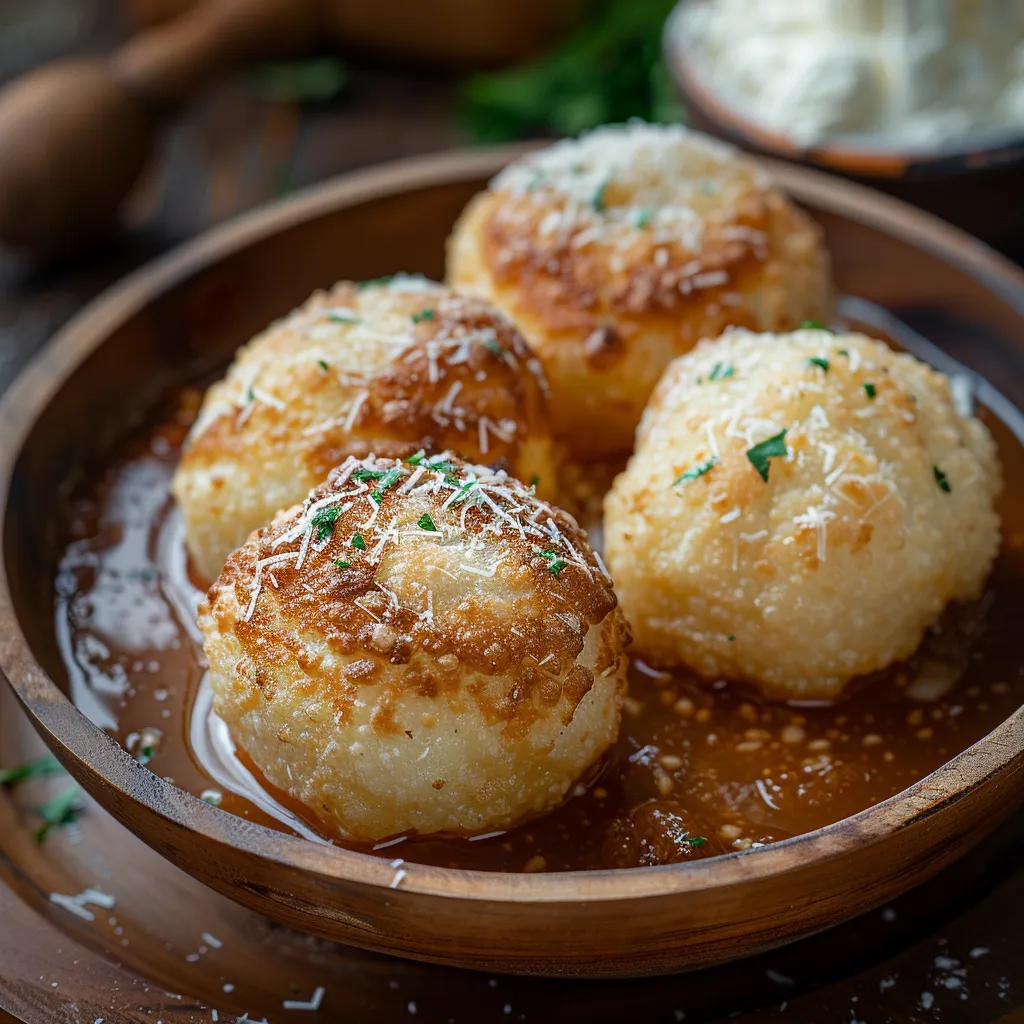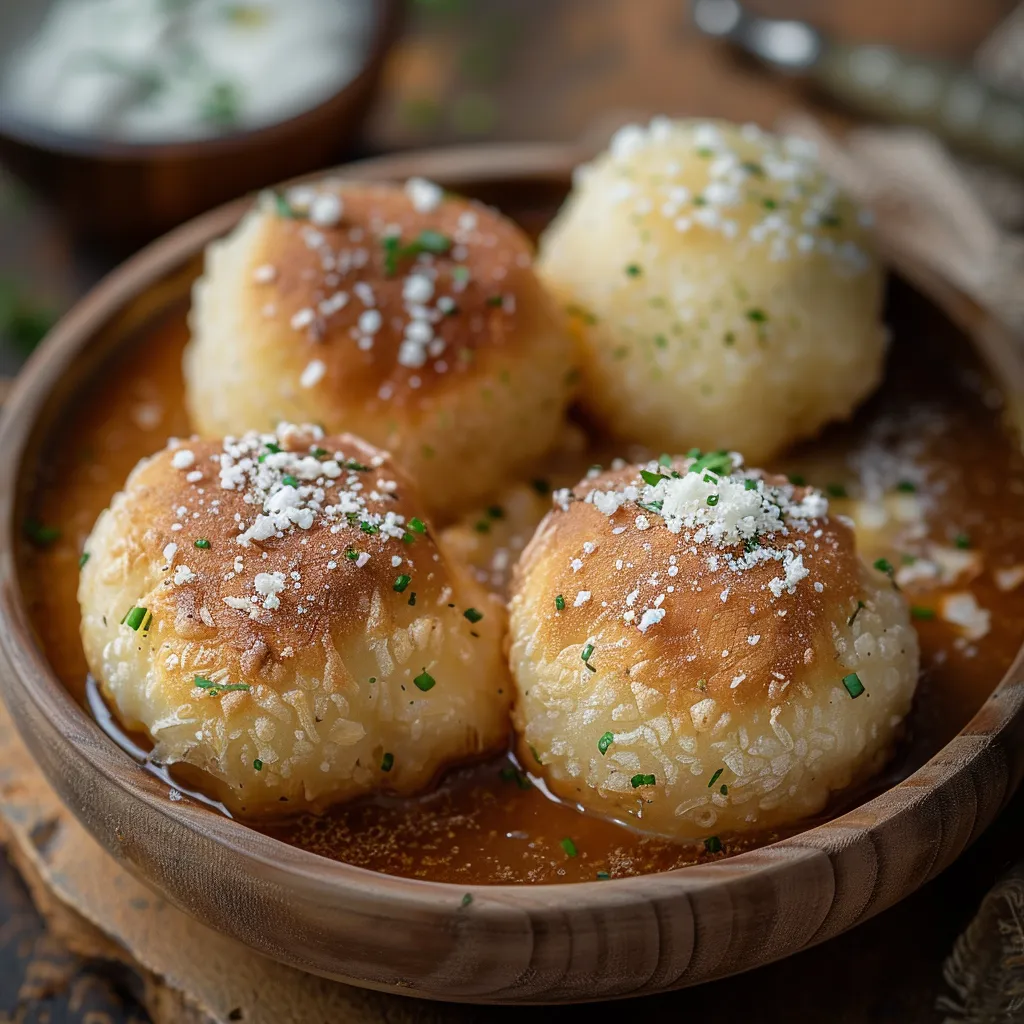 Pin it
Pin it
These homemade German bread dumplings bring the cozy flavors of old-world cooking to your kitchen using basic ingredients and time-honored methods. Semmelknödel transform yesterday's bread into fluffy, tender dumplings that go perfectly with hearty meat dishes, rich gravies, or simply fried in butter for a standalone treat you'll love.
I picked up this dumpling technique from the sweet Austrian lady next door who told me that good Semmelknödel were the foundation of any proper weekend dinner. I've tweaked my method over time, and now these soft bread dumplings are what everyone asks me to bring to family meals.
Ingredients
- Stale bread rolls or soft pretzels: Their dryness soaks up milk without turning soggy. True German brötchen are ideal, though any firm rolls will work fine.
- Milk: Gives these dumplings their soft, pillowy texture. Full-fat milk works best.
- Butter: Go for unsalted European butter for the most authentic taste.
- Onion: Brings rich savory notes when gently cooked until soft and golden.
- Fresh parsley: Adds bright color and fresh flavor.
- Eggs: Help everything stick together during cooking.
- Crispy bacon pieces: Not required but adds wonderful smoky flavor.
- Nutmeg: A small pinch brings subtle warmth to the mix.
- Salt and pepper: Don't skip these or your dumplings will taste flat.
- Fine breadcrumbs: Helps fix the texture if your mixture turns out too wet.
Step-by-Step Instructions
- Prepare the Bread:
- Slice rolls into equal cubes around half-inch big. Drop them in a large mixing bowl. Don't remove the crusts as they add nice texture and help your dumplings stay intact.
- Create the Milk Soak:
- Warm milk until hot but not bubbling. Pour it over your bread chunks and push them down with a spoon so everything gets evenly wet. Let sit for 15 minutes until the bread softens and drinks up most of the liquid.
- Sauté the Aromatics:
- Chop onion small and cook it in melted butter over medium heat for 8-10 minutes. You want them soft and golden, not brown. This slow cooking makes them sweeter and gets rid of that sharp raw onion taste.
- Combine Ingredients:
- Mix your cooked onions into the soaked bread. Stir in chopped parsley, whisked eggs, bacon bits if you're using them, nutmeg, salt, and pepper. Add two tablespoons of fine breadcrumbs to help everything stick together.
- Form the Mixture:
- Mix well with your hands until everything's blended. It should feel a bit sticky but come together nicely. Too wet? Add more breadcrumbs. Too dry? Splash in a bit more milk. Getting this right is key for perfect dumplings.
- Shape the Dumplings:
- With damp hands to stop sticking, roll the mix into balls about the size of tennis balls. Pack them firmly so they won't fall apart while cooking. You'll end up with around 12 dumplings.
- Cook Gently:
- Fill a big pot with salted water and heat until you see tiny bubbles but not a rolling boil. Drop dumplings in batches of four and cook for 20 minutes. Try cooking just one first to make sure they're holding together.
- Serve or Crisp:
- Eat them soft or slice them up and fry in butter until golden on both sides. The fried version gives you amazing crunchy outside and soft inside.
 Pin it
Pin it
My grandma always said that Semmelknödel need a gentle touch when mixing. She would warn that rough hands make tough dumplings, and she'd softly press the mixture instead of forcefully kneading it. That little bit of care is what makes these dumplings turn out so well.
Storage and Make-Ahead Tips
These dumplings keep really well. After they're cooked, let them cool down completely and stick them in the fridge for up to three days. When you want to eat them again, either warm them in some broth for 5 minutes or slice and fry them in butter. Want to keep them longer? Place cooled dumplings on a tray, freeze them solid, then pop them into freezer bags. They'll stay good for up to three months. To reheat from frozen, just simmer them in broth for about 10 minutes.
Traditional Serving Suggestions
In Bavaria and Austria, folks usually serve Semmelknödel with rich, saucy meat dishes. They're fantastic with sauerbraten, goulash, or classic German rouladen. For a full meal, put them alongside roasted meats with some braised red cabbage or sauerkraut. Don't eat meat? Try them with creamy mushroom sauce or just fry them crispy and serve with a fresh green salad.
Regional Variations
Throughout German-speaking areas, you'll notice little changes in how they're made. Tyrol versions often use speck instead of regular bacon. Some parts of Bavaria mix in chopped liver for extra richness. Certain regions shape the dough into a log and cut it after cooking instead of making separate dumplings. In Czech cooking, the similar knedlíky usually contain flour rather than bread. Every version shows off local tastes and what ingredients people can easily find.
 Pin it
Pin it
Frequently Asked Questions
- → Can I use fresh bread instead of old bread?
Not really. Older or drier bread creates a firm texture. Fresh bread could make it too sticky and hard to form.
- → How can I keep them from breaking apart while boiling?
Make the mix firm and sticky. Cook one test ball, and if needed, adjust by adding some breadcrumbs or more milk.
- → Is it possible to prepare Semmelknödel in advance?
Totally! Shape them ahead, then refrigerate for a few hours or freeze if you want to cook later.
- → What pairs well with Semmelknödel?
They're delicious with roasted meat, creamy mushroom sauces, or gravies. You can also pan-fry them as a crisp alternative.
- → Can I tweak the recipe ingredients?
Of course! Toss in bacon, herbs, or cheese to switch up the flavor just the way you like.
